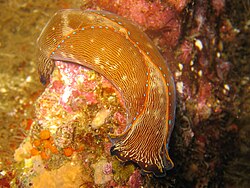Navanax inermis
| California aglaja | |
|---|---|
 |
|
| From Catalina Island, California | |
| Scientific classification | |
| Kingdom: | Animalia |
| Phylum: | Mollusca |
| Class: | Gastropoda |
| (unranked): |
clade Heterobranchia clade Euthyneura |
| Superfamily: | Philinoidea |
| Family: | Aglajidae |
| Genus: | Navanax |
| Species: | N. inermis |
| Binomial name | |
|
Navanax inermis (Cooper, 1863) |
|
| Synonyms | |
|
|
clade Euthyneura
clade Euopisthobranchia
clade Cephalaspidea
Navanax inermis, common name the California aglaja, is a species of predatory sea slug, a marine opisthobranch gastropod mollusk in the family Aglajidae and the order Cephalaspidea, the headshield slugs and bubble snails.
It has been suggested that this species should be moved to the genus Aglaja, but the name Navanax is still used in many of the popular works on mollusks.
Navanax is not a nudibranch, even though it somewhat resembles one; it belongs to a more ancient lineage of opisthobranchs called the cephalaspideans or head shield slugs and snails.
This species occurs in the eastern Pacific Ocean. Its range is from Tomales Bay, California, in the north, to Laguna Manuela and to Jalisco in Mexico, in the south, including the Gulf of California.
This species can reach a total length of more than 22 cm. It is the host of the ectoparasitic copepod Anthessius navanacis (Wilson C.B., 1935)
Navanax inermis is a voracious predator, feeding on various sea slugs and bubble snails of the order Cephalaspidea, as well as nudibranchs such as Hermissenda crassicornis, Polycera atra, and Dirona picta. It uses chemoreceptors to track the slime trails of prey, and of potential mates.
...
Wikipedia
